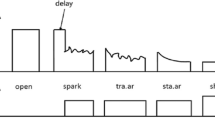Abstract
Electrical discharge milling (ED-milling) can be a good choice for titanium alloys machining and it was proven that its machining efficiency can be improved to compete with mechanical cutting. In order to improve energy utilization efficiency of ED-milling process, unstable arc discharge and stable arc discharge combined with normal discharge were implemented for material removal by adjusting servo control strategy. The influence of electrode rotating speed and dielectric flushing pressure on machining performance was investigated by experiments. It was found that the rotating of electrode could move the position of discharge plasma channel, and high pressure flushing could wash melted debris out the discharge gap effectively. Both electrode rotating motion and high pressure flushing are contributed to the improvement of machining efficiency.
Similar content being viewed by others
References
HASCALIK A, CAYDAS U. Electrical discharge machining of titanium alloy (Ti–6Al–4V) [J]. Applied Surface Science, 2007, 253(22): 9007–9016.
KIM K S, LEE C M. Prediction of preheating conditions for inclined laser assisted machining [J]. Journal of Central South University, 2012, 19(11): 3079–3083.
KIM D H, LEE C M. Development of a one-axis manipulator for laser-assisted machining [J]. Journal of Central South University, 2013, 20(2): 378–384.
CUI Hai, GUO Li-bin, ZHANG Bin, LU Xi-wen. Tribological property comparison between micro WEDM and superfinishing grinding machining surfaces [J]. Journal of Central South University: Science and Technology, 2013, 44(9): 3687–3692. (in Chinese)
SHEN Xiao-long, REN Cheng-gao, LI Kai-mo, ZHOU Zhi-xiong. Multi-axis movement processingmethod of spatial complicated curved surface of WEDM [J]. Journal of Central South University: Science and Technology, 2012, 43(12): 4329–4734. (in Chinese)
ZHANG Cheng-guang, ZHANG Yong, ZHANG Fei-hu. Mechanism of ultrasonic-pulse electrochemical compound machining based on particles [J]. Journal of Central South University, 2014, 21(1): 151–159.
RAJURKAR K P, SUNDARAM M M, MALSHE A P. Review of Electrochemical and Electrodischarge Machining [J]. Procedia CIRP, 2013, 6: 13–26.
MOHD A N, SOLOMON D G, FUAD B M. A review on current research trends in electrical discharge machining (EDM) [J]. International Journal of Machine Tools and Manufacture, 2007, 47(7/8): 1214–1228.
KUNIEDA M, YOSHIDA M, TANIGUCHI N. Electrical discharge machining in gas [J]. CIRP Annals -Manufacturing Technology, 1997, 46(1): 143–146.
TAO Jia, SHIH A J, NI Jun. Experimental study of the dry and near-dry electrical discharge milling processes [J]. Journal of Manufacturing Science and Engineering, 2008, 130(1): 011002.
HAN Fu-zhu, WANG Yong-xian, ZHOU Ming. High-speed EDM milling with moving electric arcs [J]. International Journal of Machine Tools and Manufacture, 2009, 49(1): 20–24.
GUU Y H, HOCHENG H. Effects of workpiece rotation on machinability during electrical-discharge machining [J]. Materials and Manufacturing Processes, 2007, 16(1): 91–101.
GU Lin, LI Lei, ZHAO Wan-sheng, RAJURKAR K P. Electrical discharge machining of Ti6Al4V with a bundled electrode [J]. International Journal of Machine Tools and Manufacture, 2012, 53(1): 100–106.
SAMEH H, OKADA A, UNO Y. Improving the productivity of electrical discharge machining process by using multi-thin electrodes [J]. Machining Science and Technology, 2013, 17(1): 110–128.
ÇOGUN C, DENIZ T Ç, KUCUKTURK G. A geometrical approach for reduction of tool shape degeneration in electric discharge machining (EDM) [J]. Machining Science and Technology, 2012, 16(3): 445–458.
SUBRAMANIAN R, MARIMUTHU K, SAKTHIVEL M. Study of crack formation and re-solidified layer in EDM process on T90Mn2W50Cr45 tool steel [J]. Materials and Manufacturing Processes, 2012, 30(2): 199–203.
MUTHURAMALINGAM T, MOHAN B. Influence of discharge current pulse on machinability in electrical discharge machining [J]. Materials and Manufacturing Processes, 2013, 28(4): 375–380.
MUTHURAMALINGAM T, MOHAN B, RAJADURAI A, SARAVANAKUMAR D. Monitoring and fuzzy control approach for efficient electrical discharge machining process [J]. Materials and Manufacturing Processes, 2014, 29(3): 281–286.
BLEYS P, KRUTH J P, LAUWERS B, ZKYD A, DELPRETTI R, TRICARICO C. Real-time tool wear compensation in milling EDM [J]. CIRP Annals -Manufacturing Technology, 2002, 51(1): 157–160.
ZHOU Ming, HAN Fu-zhu, SOICHIRO I. A time-varied predictive model for EDM process [J]. International Journal of Machine Tools and Manufacture, 2008, 48(15): 1668–1677.
ZHOU Ming, HAN Fu-zhu, WANG Yong-xian, ISAGO S. Assessment of dynamical properties in EDM process—detecting signature of latent change to deleterious process in advance [J]. The International Journal of Advanced Manufacturing Technology, 2008, 44(3/4): 283–292.
KUNIEDA M, LAUWERS B, RAJURKAR K P, SHUMACHER B M. Advancing EDM through fundamental insight into the process [J]. CIRP Annals-Manufacturing Technology, 2005, 54(2): 64–87.
Author information
Authors and Affiliations
Corresponding author
Additional information
Foundation item: Project(MSV-2013-09) supported by State Key Laboratory of Mechanical System and Vibration, China
Rights and permissions
About this article
Cite this article
Guo, Cb., Wei, Db. & Di, Sc. Improving energy utilization efficiency of electrical discharge milling in titanium alloys machining. J. Cent. South Univ. 23, 2550–2557 (2016). https://doi.org/10.1007/s11771-016-3316-5
Received:
Accepted:
Published:
Issue Date:
DOI: https://doi.org/10.1007/s11771-016-3316-5




